Bayonet Drill
The following information is taken from a 1916 reprint of the "Règlement de Manuvre d'Infanterie du 20 Avril 1914" ("Infantry Maneuver Regulation of April 20, 1914"). Based solely off photographic evidence, the bayonet drill described by this regulation had been significantly scaled back from previous regulations. (Note in the photos posted below certain positions that are not covered in the text below.)
Fighting with the bayonet.
La baïonnette is the supreme weapon of the foot-soldier. It plays the decisive role in the assault to which it must hold/aim resolutely all attacks, and which, alone allows one to definitively put the adversary out of action.
The goal of bayonet fighting instruction is to prepare the man for hand-to-hand fighting with foot-soldiers and cavalrymen. It greatly contributes to inspire confidence and to raise morale strengths.
The principles of bayonet fighting are:
GARDE
The guard is taken up directly, while marching or standing still, starting from no particular position: charge step, weapon in hand, firing position, etc. With the instruction, it is taken at the command of:
EN GARDE. 1
(“On Guard”)
The weapon is maintained horizontal with both hands, the right forearm against the cartridge pouch, the right hand at the small of the butt and detached from the body, the left hand grasping the weapon at the sling, between the grenadière [upper sling swivel] and the bolt box, the point of the bayonet aligned with the left hip, the top of the muzzle turned to the left, the lever inclined at around a 45 degree angle.;
The feet are about 50 centimeters (20") apart, the right foot behind and a little to the right of the left foot, the toes pointing out, the legs slightly bent, the top of the body leaning forward slightly.
These positionings relate to the instruction while standing still. In combat, to attack the adversary as rapidly as possible, the guard is generally taken while marching, not stopping to do so, with the man simply dropping the weapon down to a close approximation of these positionings.
1 Left-handers can practice the guard in the left-handed position.
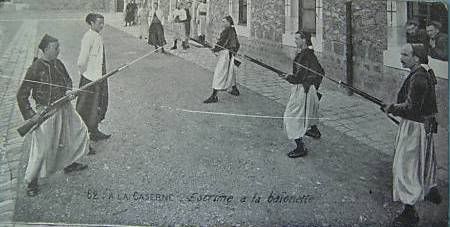
Postcard showing zouaves training with the bayonet, in the En Garde position.
REPOS.
(“Return”)
Straighten the legs, let go of the weapon with the right hand and continue holding it with the left hand, the butt placed on the ground.
DISPLACEMENTS
The displacements serve to achieve or to break the “measure”2, to dodge an attack, to assure or complete a parry.
2 The “measure” is the greatest distance in which a man can reach his adversary with the bayonet.
EN AVANT (EN ARRIÈRE). APPUYEZ A DROTE (A GAUCHE).
(“To the Front [to the Rear]. On the Right [Left], Close.”)
Carry one foot to the desired location, place the other foot in its position.
FACE A UN POINT.
(“Face [to a certain point]”)
Face toward the adversary turning on the heel the amount desired. Immediately place the other foot in its position.
The above displacements can be combined into an oblique direction. For example:
“EN AVANT, FACE A UN POINT, APPUYEZ A GAUCHE.”
(“To the Front, Face to ___, On the Left, Close.”)
They can also be executed in leaps.
ATTACKS AND PREPARATIONS
POINTEZ.
(“Point”)
Thrust the weapon lively with both hands, the muzzle rotating left or facing up, carry the top of the body forward, extending the right hamstring. If necessary, push forward with the left foot and let the weapon slide in the left hand. Immediately return to the “on guard.”
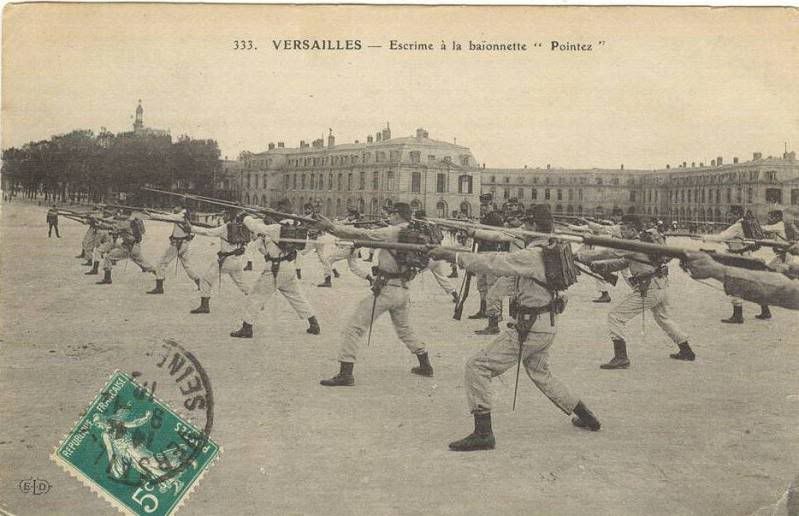
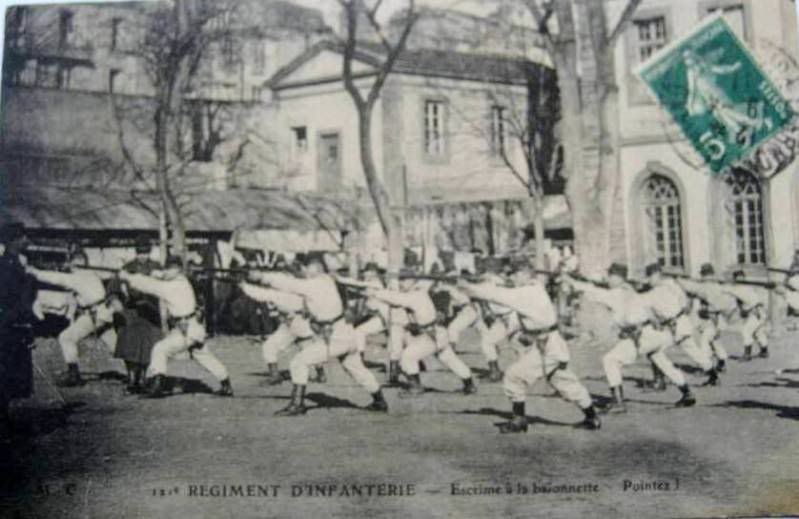
Postcards showing troops training with the bayonet, in the Pointez position.
LANCEZ.
(“Thrust”)
Thrust the weapon lively with the right hand extending out the arm, the muzzle facing up. Let go with the left hand, which stands ready to seize the weapon again immediately. Push forward with the left foot, extend the right hamstring. Immediately return to the “on guard.”
In the attack, the lunge must not be exaggerated. The “POINTEZ” may be directed against all parts of the body. In principle, the “LANCEZ” aims from afar, especially the chest of the foot-soldier, the head of the horse or the flank of the cavalryman.

Photo showing Spahi troops training with the bayonet, in the Lancez position.
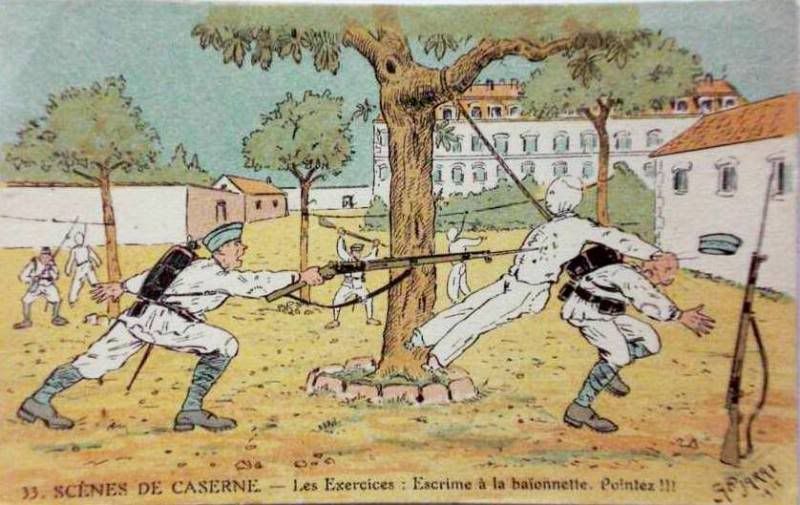
Humorous postcard showing an eager recruit training with the bayonet, in the Lancez position.
BATTEZ.
(“Beat”)
Strike the enemy’s weapon briskly in order to divert it.
OPPOSEZ.
(“Oppose”)
Exert a strong pressure on the enemy’s weapon.
DÉGAGEZ.
(“Disengage”)
Pass the point under the enemy’s weapon.
The beat off, the opposition and the disengagement are executed with the left hand, the weapon pivoting around the right hand, which may need to be displaced. The beat off and the opposition serve to ward off the enemy’s point, to prepare the attack, and to parry.
PARRIES AND RIPOSTES*
PAREZ.
(“Parry”)
While in the guard position, raise the right elbow out and up to the level of the head, the right forearm rotating outwards while doing so, as the left hand loosening its grip enough to allow the stock to rotate as needed.
Pre-war color photograph of bayonet training showing a man in the parry position.
PARADE ET POINTEZ/LANCEZ.
(“Parry and Point/Thrust”)
Drive off the enemy’s point or blade with a beat or with an opposition. Immediately riposte with a “POINTEZ /LANCEZ.” The parry is either low (bas) or high (haut), to the right (á droite) or to the left (á gauche), accordingly, preferably to the right in order to avoid a double hit by the enemy.
As needed, against a cavalryman armed with a saber, both hands can displace and lift up in order to facilitate the parade and the riposte.
USE OF THE BUTT
Swing the butt forward and strike with both hands, with the butt plate, and with the flat side of the butt.
If it is necessary, employ besides any other means to strike down the adversary (a low kick, shin kick, push, etc.).
*Parade, or Parry: to deflect or ward off (a thrust, stroke, weapon, etc.).
Riposte: a return thrust, which is delivered after parrying; not, to be understood, after making a parry.
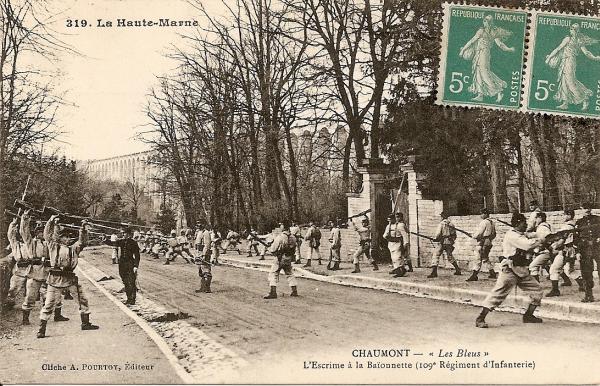
Pre-war postcard of new recruits of 109th R.I. being drilled in the use of the bayonet.

Three soldiers equipped for bayonet practice in 1914. Note the fencing masks and cushioned bayonet points. The soldier in the center is Jules Gadou, 23, who would be killed on August 23, 1914.







